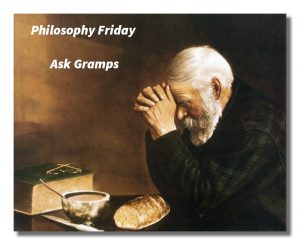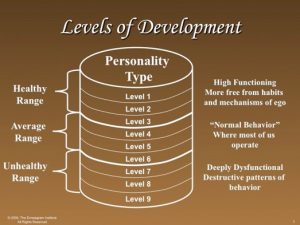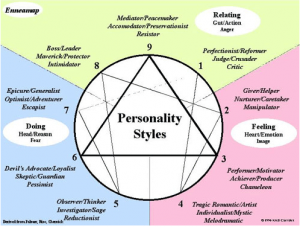
Shownotes
Wisdom-Trek / Creating a Legacy
Welcome to Day 1018 of our Wisdom-Trek, and thank you for joining me.
This is Guthrie Chamberlain, Your Guide to Wisdom
The Enneagram Type Combinations – 2&5; 2&6; 2&7 – Ask Gramps

Wisdom – the final frontier to true knowledge. Welcome to Wisdom-Trek! Our mission is to create a legacy of wisdom, to seek out discernment and insights, and to boldly grow where few have chosen to grow before.
Hello, my friend, I am Guthrie Chamberlain, your captain on our journey to increase wisdom and create a living legacy. Thank you for joining us today as we explore wisdom on our 2nd millennium of podcasts. This is Day 1018 of our trek, and it is time for our Philosophy Friday series. Each Friday we will ponder some of the basic truths and mysteries of life, and how they can impact us in creating our living legacy.
As we continue on this trek called life, sometimes we have questions about life, so our Friday trek is a time where we can “Ask Gramps.” Gramps will answer questions that you would like to ask your dad or granddad, but for whatever reason, this is not possible. No matter how old we are, I know that all of us would like the opportunity to ask Dad or Gramps questions about life in many areas.
As we continue on this trek called life, sometimes we have questions about life, so our Friday trek is a time when we can “Ask Gramps.” Gramps will answer questions that you would like to ask your dad or granddad, but for whatever reason are unable to. No matter how old we are, I know that all of us would like the opportunity to ask Dad or Gramps questions about life in many areas.
Understanding ourselves and how others may interpret life through their paradigm better allows us to interact with each other with more love and compassion. This can be achieved by utilizing a profound tool called “The Enneagram.” The tool that we refer to as the Enneagram (Any-a-Gram) is a circle with nine interconnected points (Ennea refers to 9 and Gram referring to a drawing). Check out today’s or a prior week’s Wisdom Journal for a representation of it. I have also included a copy of “The Enneagram At-A-Glance,” which was compiled by Suzanne H. Eller in today’s Wisdom Journal. If you would like a PDF copy, click on the link in today’s Wisdom Journal located on our website Wisdom-Trek.com.
For additional insight, I recommend the book The Road Back to You written by Ian Morgan Cron and Suzanne Stabile. It is an excellent book about an enneagram journey to self-discovery from a Christian perspective.
We have concluded our deep dive into the nine types which are “The Reformer,” “The Helper,”“The Achiever,” “The Individualist,” “The Investigator,” “The Loyalist,” “The Enthusiast,” “The Challenger,” and “The Peacemaker.” Four weeks ago, we began a series of episodes on Type Combinations, answering the question, “What are the potential relationship benefits and issues with each combination?” Covering all of the 45 different potential type combinations will take several weeks, but will be valuable in understanding each other, regardless of what type you are and what type those with whom you interact with each day are.
Since we are exploring the Enneagram in detail, I would also recommend reading the Wisdom Journal for each Friday to see the diagrams presented each week. As helpful as the Enneagram is, keep in mind, it is still only a tool and cannot replace or usurp the precepts that are found in God’s Word. All decisions and actions that we make in life must be in harmony with God’s precepts.
So the questions for the next several weeks will be…
“Hey, Gramps, why do people act and react to situations and circumstances in life so differently? How can I gain wisdom to better understand myself and others so that I can love, serve, and minister to them on a deeper level?”
The Enneagram Type Combinations

The Enneagram Type Combinations
Enneagram Type Two (the Helper)
with
Enneagram Type Five (the Investigator)
What Each Type Brings to the Relationship
Enneagram Twos and Fives are double opposites, as it were—a people person versus a loner, a feeling type with a thinking type. Twos and Fives come from different points of view on what is important in life and in a relationship. And yet, because they are so different, there can also be an intense attraction to the mystery of the other. Twos and Fives are a more common pairing than might be expected: Twos can see Fives as challenges—distant, mentally preoccupied, not giving many outward signals, and difficult to charm easily because they are so private. It is hard to know what pleases Fives which makes Twos only try harder. Twos bring to the relationship a willingness to take the initiative and to pursue the Five—to be the first one to call or to ask for a date, no matter which gender they are. When healthy, Twos bring warmth, physical comfort and ease (something Fives typically lack), a desire to improve the Five’s living conditions, style of dress and eating habits—and many other marks of thoughtfulness as signs of affection and genuine interest. Fives are usually not unaware of these though they may not outwardly react to the expressions of affection of Twos, Fives are secretly pleased that someone cares and is being attentive to them.
For their part, Fives are usually very loyal: they find relationships complex and difficult, so they tend to value one that begins to work. And they tend to put energy into it. Fives bring stability and quiet, dispassionate good judgment and objectivity, particularly in crises. When Fives focus, they are good listeners and give undivided attention. They are not as attached to outcomes, and so can often make decisions more wisely and be good advisors to more emotionally volatile Twos. Fives are often more calm than Twos, and this gives them both a feeling of steadiness and hope. In short, Fives stabilize Twos’ emotionality, while Twos warm up Fives’ coolness. Twos enjoy seeing that their attention and affections have had positive, visible effects on the Five. Fives secretly like being doted on and finally finding the nurturing they have unconsciously been seeking (but may have almost given up on).
Potential Trouble Spots or Issues
Many of the issues that this couple faces have to do with their boundaries and how respectful or not each is of the other. Twos tend to become frustrated by the Five’s lack of immediate response to them—sometimes Fives are so taciturn and involved in their own mental world that there is no response at all—which hurts the Two’s feelings and feels like a rejection to them. Feeling rejected triggers deep anxieties in Twos relating to the fear that they are unwanted and unloved. This may make them redouble their efforts to get some kind of response from the Five. They may become more talkative, more curious and questioning of the Five, and more demanding-physically hoisting the Five from her desk or barging into her library to drag her out dancing or to a movie because she needs a break from work. Much of the Two’s activities become a form of intrusion that has, at its root, the need to reassure himself that the Five is still connected with him.
But the more intrusive Twos become, the more Fives internally withdraw and detach emotionally from what feels like a threat to their autonomy and competence. Fives start to lose confidence in themselves and are actually harmed by being overly helped. Lower functioning Twos, however, feel that they have no value unless they are actively involved in every aspect of the other’s life. But the more they feel intruded on, the more unsafe Fives begin to feel. And they may start to fear the Two (because they seem irrational and out of control to the Five). Fives can also become cynical about the value and viability of relationships—and cynical about the possibility of finding one that works for them. Fives tend to walk away from the entire question, losing interest in having an intimate relationship often for years at a time. But the more distance Fives put between themselves and Twos, the more this brings out the Twos’ obsessions and the more aggressive they become in their pursuit of the Five. It is a prescription for disaster, or at least loneliness, for both.

Enneagram Type Two (the Helper)
with
Enneagram Type Six (the Loyalist)
What Each Type Brings to the Relationship
Both Enneagram Twos and Sixes are highly dutiful and take their responsibilities toward each other very seriously. The emphasis tends to be slightly different, however, with Twos focused primarily on building intimacy and positive feelings between themselves and other individuals, whereas the emphasis of Sixes tends to be on building a foundation of security, a sturdy platform of hard work and trust that everyone can count on. Both types are highly responsible and tend to put the needs of others before their own. They are both family oriented and foster domesticity; they easily share duties around the house and with their children or friends. They are both socially involved in their community and see great value in having many social connections which give them the feeling that they are valued in their world. Sixes value the warmth, kindheartedness, generosity, and self-sacrifice of the Twos. Sixes are aware of how well suited Twos are to be an excellent, devoted spouse and parent, and that they could be trusted to be loyal.
On the other hand, Twos will likely admire the hard work, steadfastness to commitments, perseverance, modesty, and playfulness of Sixes. Even if they should sometimes be grumpy and indecisive, Twos realize that healthy Sixes almost always come around in the end. Caution and vigilance are recognized as worthwhile assets in what can be a cruel and exploitative world. Twos often feel that they can count on the Six’s watchfulness to spot difficulties before they become problems. When Twos and Sixes are healthy, they may actually admire each other more than they feel a grand passion for each other. Their relationship may be based more on steadiness, mutual respect, and affection than on some kind of overheated chemistry between them. They see the other as good and dependable, and that is often more than enough as a basis for an enduring and productive life together.
Potential Trouble Spots or Issues
One of the main potential areas for problems between Twos and Sixes has to do with control and autonomy, between being too close and being too far apart. Part of the problem has to do with the lack of confidence of lower functioning Sixes and their ability to make decisions and to be decisive. Average Sixes tend to feel pressured by all kinds of competing demands on their time and energy—by the Two, by the boss, by friends, by their church, and even by their country. Pressure from all sides makes Sixes feel more anxious and emotionally unstable, unable to think clearly or to make decisions easily. They can become doubtful, suspicious, and negativistic. As Sixes become more reactive, they are likely to impulsively take almost any action just to relieve their anxieties momentarily. At such times, Twos may begin to offer them more help and advice, or to issue “orders” as a way to empower the Six and help them through their anxiety.
However, Sixes usually perceive the Two’s help as intrusiveness and undermining of their self-confidence, and they resent it. Cycles of anxiety and acting out, followed by tearful reunions, followed by needing to be more autonomous on the Six’s part, followed by more intrusion on the Two’s part, can wear this relationship down. The problem is that lower functioning Twos think there is no such thing as too much intimacy since they always want to be closer. However, Sixes are more ambivalent, pushing the Two away and then pulling them closer. The Six’s ambivalence and inconsistency drives the Two crazy and taps into fears of rejection. Twos will up the ante by trying to help the Six more although Sixes experience their help as control and seek more distance. This pair can become enmeshed in a bad child, punishing parent drama that can ultimately be fatal to their relationship and the real mutual respect that it was potentially founded on.

Enneagram Type Two (the Helper)
with
Enneagram Type Seven (the Enthusiast)
What Each Type Brings to the Relationship
In many ways, both of these types can look alike. Both Enneagram Twos and Sevens can be outgoing, friendly, funny, high-energy people and very enjoyable company. They want others to be happy and to have a good time, and both types tend to interpret things (including setbacks) in a positive way—always looking for the silver lining or the blessing in a seeming disaster. Both types are engaging and spontaneous and love the good things of life. In addition, Twos bring a depth of feeling and concern for the welfare of others into the mix. Twos admire the nerve and gusto with which Sevens plunge ahead in life, making every day an unpredictable adventure. Sevens bring high energy, and a quick mind that sees possibilities and generates ideas faster than they can be acted on. There is a kind of mental electricity and excitement that Sevens generate—the aura of sheer possibility that Twos find intoxicating, not only for themselves but for those they want to share their excitement with. The Seven helps the Two to remember to do nice things for him or herself on a regular basis. They remind Twos that if they are not taking care of their own health and fulfillment, they will not really be able to be helpful to others. On the other hand, healthy Sevens feel that their emotional and physical needs are largely met by a healthy Two. The Two helps the Seven feel relaxed and fulfilled, reducing the temptation to wander.
Further, both Twos and Sevens are idealistic, but Twos can more easily and consistently translate this impulse into altruistic action. This inspires the Seven who also enjoys sharing abundance with others. Together, they can be remarkably generous and thoughtful as a couple. The Two and Seven combination can have a positive effect on people that is virtually unmatched by any other couple: they can be warm, welcoming, and generous, making others feel loved and invited to the party.
Potential Trouble Spots or Issues
In time, Twos feel that they can never have enough intimacy, and they usually try to find ways to be closer to the Seven. They like to stay at home, go on quiet walks together, cook, and talk about settling down and having a family. Sevens, on the other hand, generally find the idea of settling down and limiting their options to be nowhere nearly as attractive. Sevens are capable of long-term commitments, but they tend not to be eager to get into them. As a result of these signals, the Two may start to hover and become more intrusive, pulling in the reins on the Seven, insisting that they have more quality time together. Sevens can easily feel trapped by this maneuver, and they may begin to lose interest in the Two, feeling that the relationship has gone stale (rather than realizing their own anxiety over the potential closing of options). Twos will increasingly want to get serious about the relationship just as the Seven begins to feel bored or that the relationship has gotten heavy and unfulfilling. Twos can thus begin to see the Seven as untrustworthy, a playboy (or playgirl) who is selfishly leading them on with no intention of tying the knot. Sevens can begin to see Twos as possessive and manipulative, playing on their guilt or insecurities to make sure the Seven does not stray.
Further, Sevens need to be the center of attention as a way of staying energized and excited. Other people and their needs are not really the focus of their concern as much as they are an audience of potential playmates if others can keep up with them...